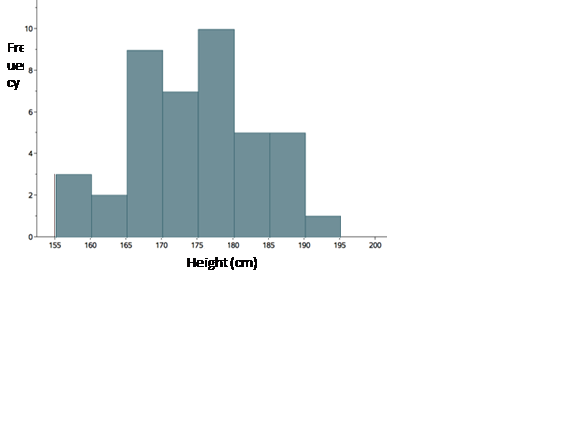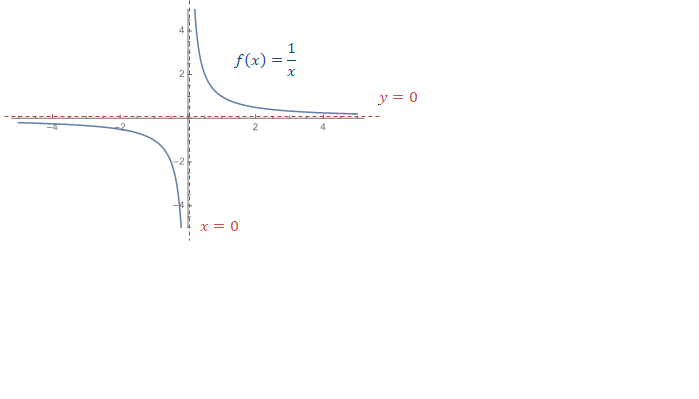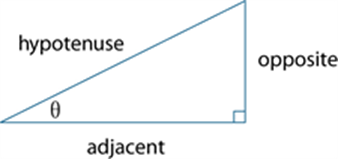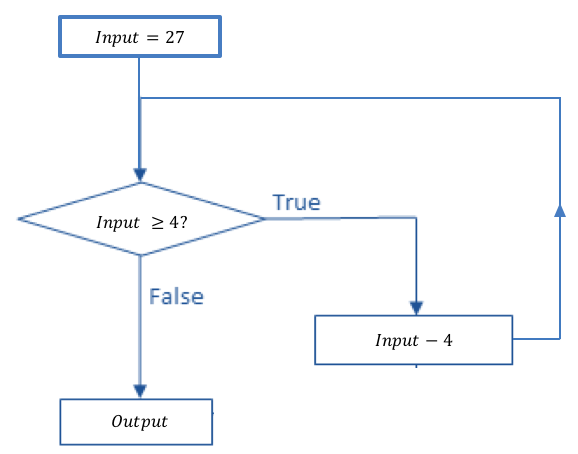Histogram
A histogram is a statistical graph for displaying the frequency distribution of continuous data. It is also a graphical representation of the information contained in a frequency table.
In a histogram, class frequencies are represented by the areas of rectangles centred on each class interval. The class frequency is proportional to the rectangle’s height when the class intervals are all of equal width.
The histogram below displays the frequency distribution of the heights (in cm) of a sample of 42 people with class intervals of width 5 cm

See also: frequency
Hyperbola (rectangular hyperbola)
Hyperbola is the non-connected intersection of a double cone and a plane. The rectangular hyperbola has perpendicular axes (or asymptotes).
The function ![]() is an example of a rectangular hyperbola, as shown below:
is an example of a rectangular hyperbola, as shown below:

See also: asymptotes
Hypotenuse
The longest side of a triangle in a right-angled triangle (opposite the right angle as shown).

See also: trigonometry.
I
Identity
An identity is an equation that is true for all values of the variables involved over their natural domain, for example ![]() for all real numbers
for all real numbers ![]() and
and ![]() .
.
Identity (element)
An element of a set which, when combined (using a given operation) with any other element of the set, leaves that element unchanged is an identity.
For example, 0 is the identity element for addition of natural numbers, since for any natural number ![]() it is the case that
it is the case that ![]() and
and ![]() .
.
Similarly, 1 is the identity element for multiplication of natural numbers, since for any natural number ![]() it is the case that
it is the case that ![]() and
and ![]() .
.
See also: addition, multiplication, zero.
Image (geometry)
In geometry, the image is a result of a transformation. See also: transformation.
Implication
An implication is a statement of the form if ... then ... An implication is understood to be true unless the first part of the statement is true but the second part of the statement is false.
Implementation
Implementation is the process of translating an algorithm in to a coding language.
Inclusion (subset)
A set A is a subset of another set B if all of the elements of A are also elements of B. For example, if A = {vowels} and B ={letters of the alphabet} then A is a (proper) subset of B, written symbolically as A ⊂ B. In the case where A is required to be a subset of B, but may include all of the elements of B then this is represented symbolically by A ⊆ B.
Independent event
Two events are independent if knowing the outcome of one event tells us nothing about the outcome of the other event. We can express this, for example, as ![]() . This means that the probability of A given B is equal to the probability of A, that is, event B has no bearing on the probability of event A occurring. See also: probability.
. This means that the probability of A given B is equal to the probability of A, that is, event B has no bearing on the probability of event A occurring. See also: probability.
Index
The index (exponent or power) of a number or algebraic expression is the power to which the latter is be raised. For example, for ![]() the index is 3. For
the index is 3. For ![]() the index is
the index is ![]() .
.
In general, if ![]() is a positive real number and
is a positive real number and ![]() and
and ![]() are positive integers then
are positive integers then
![]() . See also: index laws, logarithm.
. See also: index laws, logarithm.
Index laws
Index laws are rules for manipulating indices (exponents). They include:
See also: index.
Indices
Plural. See: index.
Inequality
An inequality is a mathematical expression containing the terms ‘less than’, ‘less than or equal to’, ‘greater than’, or ‘greater than or equal to’ their respective symbolic representations ‘<’, ‘≤’, ‘>’ and ‘≥’. For example, ‘the set of prime numbers less than or equal to 29’, is an inequality, as is the expression ![]() where
where ![]() and
and ![]() are real numbers.
are real numbers.
Inequalities can also be represented on a number line where closed dots represent numbers included in an interval and open dots numbers not included. For example, the inequality ![]() could be represented on a number line as:
could be represented on a number line as:

See also: number line.
Inference
An inference is an assertion made on the basis of analysis from given data or propositions; for example, on the basis of the weather patterns observed over several years, a farmer might infer that it is likely to be a hot summer. See also: data, proposition.
Infinite
The set of natural numbers N = {0, 1, 2, 3 ...} is an example of an infinite set. There are many examples of infinite sets, the set of all prime numbers is an infinite set (there is no largest prime number).
The set of natural numbers, N, is an example of an infinite set which has a smallest element, 0, but no largest element. The set of integers Z = {... −3, −2, −1, 0, 1, 2, 3 ...} is an example of an infinite set which has no smallest or largest element.
The set {0.9, 0.99, 0.999, 0.9999, ... , 1} is an example of an infinite set which has both a smallest element, 0.9, and a largest element, 1.
It is not possible for the elements of any infinite set to be put in a one-to-one correspondence with the elements of a set of the form {0, 1, 2, 3, ... , ![]() } where
} where ![]() is a natural number.
is a natural number.
See also: natural numbers, correspondence.
Informal unit
An informal unit is one where the value is decided on in a given context, for example, the use of a pace to measure distance or the use of a cupped hand to measure capacity of rice for a meal (irregular informal units). An informal unit may also be regular, such as the use of paperclips to measure length or a drinking glass to measure a small amount of a substance (capacity). Informal units are not part of a standardised system of units for measurement.
Integer
An element of the infinite set of numbers ![]() .
.
Intercept (graphs)
The point at which a curve or function crosses an axis or other curve in the plane is an intercept. Specifically,
See also: x, y, axis.
Interior angle
For polygons, angles formed by two adjacent side within the polygon are interior angles.
Interior angles are also the four angles formed when a transversal cuts through two straight lines. The angles formed at the intersection of the transversal and the two lines, and located between the two lines, are the interior angles. See also: transversal, polygon
Interpolation
Working within known data to make predictions between these data values, for example working between two known points on a graph to predict a value in between these points.
Interquartile range (IQR)
The interquartile range (IQR) is a measure of the spread within a numerical data set. It is equal to the upper quartile (Q3) minus the lower quartile (Q1); that is, IQR = Q3 – Q1.
The IQR is the width of an interval that contains the middle 50% (approximately) of the data values. To be exactly 50%, the sample size must be a multiple of four.
See also: five number summary, numerical data.
Intersection (set)
Given two sets A and B, their intersection, written A ∩ B, is the set of all elements common to both sets. If A and B have no elements in common, their intersection is the empty set { }. For example, if A = { a , b , d , z } and B = { a , c , x , y , z } then A ∩ B = { a , z }; however, if
C = { m , n } then A ∩ C = { }.
Interval (in R)
An interval is a continuous subset of the real number line, for example ‘the set of all real numbers greater than or equal to 10’ which can also be written as ![]() or simply as
or simply as ![]() when it is assumed that
when it is assumed that ![]() is a real number. Alternatively, the interval notation [10, ¥) can be used.
is a real number. Alternatively, the interval notation [10, ¥) can be used.
Similarly the interval between -1.5 and 2.3 not inclusive of these two values can be specified as ![]() or simply as
or simply as ![]() when it is assumed that
when it is assumed that ![]() is a real number. The corresponding interval notation is (-1.5, 2.3).
is a real number. The corresponding interval notation is (-1.5, 2.3).
Invariance
The property of not changing under a process such as transformation; for example, the points on a mirror line are invariant under the transformation of reflection in that mirror line. If a person touches a mirror with their finger, then the point of contact will be invariant under reflection in the mirror, all other points on their image will have left- and right-hand senses reversed. See also: transformation.
Inverse
For each element of a set, its inverse with respect to a given operation defined on the set is the element in the set which, when they are combined using the operation, results in the identity element. For example, the inverse of the integer + 4 with respect to the operation of addition is the integer −4 since + 4 + (−4) = 0 and −4 + (+ 4) = 0 (with zero being the additive identity). The inverse of the rational number ![]() with respect to the operation of multiplication is the rational number
with respect to the operation of multiplication is the rational number ![]() since
since ![]() (where 1 is the multiplicative identity).
(where 1 is the multiplicative identity).
See also: identity, inverse machine.
Inverse machine
A function machine which applies inverse operations to an input when compared to the original function machine.
For example, for a function machine which takes an input and multiplies it by 2 for the output, the inverse machine would take an input and divide by 2 for the output. This could be represented by the diagram below:

See: function machine, inverse.
Investigation
Exploration of a situation or context.
Irrational number
A number that cannot be expressed as a fraction in the form ![]() , where
, where ![]() and
and ![]() are integers and
are integers and ![]() is non-zero, is an irrational number. The decimal form of such numbers does not terminate, and is non-recurring, that is, there is no finite sequence of digits that repeats itself.
is non-zero, is an irrational number. The decimal form of such numbers does not terminate, and is non-recurring, that is, there is no finite sequence of digits that repeats itself.
For example, ![]() is part of the decimal expansion of an irrational real number. Numbers such as
is part of the decimal expansion of an irrational real number. Numbers such as ![]() , the golden ratio
, the golden ratio ![]() , and
, and ![]() are examples of irrational numbers. See also: decimal.
are examples of irrational numbers. See also: decimal.
Irregular polygon
A polygon with not all sides or angles equal is an irregular polygon. See also: polygon, angle.
Isometry
See: transformation.
Iteration
The repetition of a process a specified number of times, or until a condition is satisfied, is the process of iteration. This may be achieved by using loops, for example. An example of iteration could be subtracting 4 from 27 six times, or subtracting 4 from 27 until the result is less than 4. For the second example, a flowchart could illustrate this:

See also: flowchart.
Source: https://victoriancurriculum.vcaa.vic.edu.au/LearningArea/LoadFile?learningArea=mathematics&subject=mathematics&name=Mathematics%20Glossary.docx&storage=Glossary
Web site to visit:ttps://victoriancurriculum.vcaa.vic.edu.au
Author of the text: indicated on the source document of the above text
If you are the author of the text above and you not agree to share your knowledge for teaching, research, scholarship (for fair use as indicated in the United States copyrigh low) please send us an e-mail and we will remove your text quickly. Fair use is a limitation and exception to the exclusive right granted by copyright law to the author of a creative work. In United States copyright law, fair use is a doctrine that permits limited use of copyrighted material without acquiring permission from the rights holders. Examples of fair use include commentary, search engines, criticism, news reporting, research, teaching, library archiving and scholarship. It provides for the legal, unlicensed citation or incorporation of copyrighted material in another author's work under a four-factor balancing test. (source: http://en.wikipedia.org/wiki/Fair_use)
The information of medicine and health contained in the site are of a general nature and purpose which is purely informative and for this reason may not replace in any case, the council of a doctor or a qualified entity legally to the profession.
The texts are the property of their respective authors and we thank them for giving us the opportunity to share for free to students, teachers and users of the Web their texts will used only for illustrative educational and scientific purposes only.
All the information in our site are given for nonprofit educational purposes